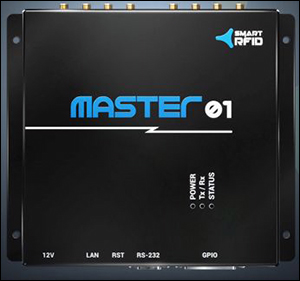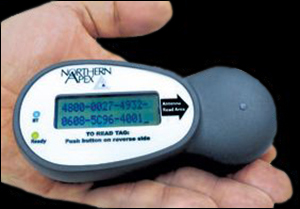The following are news announcements made during the past week by the following organizations:
Tyco Retail Solutions;
Smart Technology Group;
Northern Apex;
Quuppa;
Invengo Technology, and Cisper Electronics.
Tyco Retail Solutions Adds Fitting Room Analytics to Its TrueVUE Software Suite
Tyco Retail Solutions has announced the addition of the TrueVUE fitting room analytics application to its suite of TrueVUE applications and analytics software. The application is designed to provide deeper insights for a more detailed level of activity in and around fitting rooms, and works with Tyco’s integrated platform across electronic article surveillance (EAS), store traffic and inventory to better serve customers and minimize loss in this traditional “high risk” security zone, the company reports. In addition, RFID technology in fitting rooms helps retailers gain new insights into what items were tried on and purchased.
Having an RFID-enabled fitting room provides real-time information regarding which products are brought into the fitting room and which are purchased. Tyco, for example, offers a steerable-beam ultrahigh-frequency (UHF) RFID antenna that, according to the company, can indicate not only a tagged item’s location, but also the direction in which it is moving. Its IDA-3100 antenna, used with Tyco Retail Solutions’ Sensormatic IDX 2000 or IDX 8000 reader and TrueVue software, can provide details regarding how items move within a specific space, such as a fitting room or doorway, and the ways in which customers interact with products (see Tyco Retail Solutions’ Steerable Beam Antenna Brings Movement Data to Retailers).
With the new TrueVUE fitting room analytics application, retailers can access fitting room reports that offer key metrics on individual items entering the fitting room. Those metrics include duration of items in a fitting room, items coming into the fitting room together, conversion of fitting room items into sales, and abandonment of fitting room items. Retailers can also learn whether delays in items being removed by associates in a timely manner are causing out-of-stocks, as well as whether staffing is in synch with the peak days and times of shopper activity. Additionally, retailers gain new insights into loss events within the fitting room, with information collected about tags being removed from items and whether large quantities of similar items in fitting rooms indicate potential theft events.
Smart Technology Group’s Master 01 RFID Reader Gets ‘Smart Mode’
Swiss and Polish technology startup Smart Technology Group has announced an upgrade to its flagship product, the Master 01 RFID reader. The new version includes smart mode, a functionality that enables the reader to recognize tags independently of their Electronic Product Code (EPC) or tag ID (TID) numbers. Until now, RFID reader Master 01 could only work in three modes: polling, automatic and autonomous.
According to Karolina Kozlowska, Smart Technology Group’s CEO, smart mode is designed to provide more accurate, precise tag reading and also protect against fake or compromised tags. “It is commonly known that there are several factors seriously impeding TID number identification,” she explains. “They are generally difficult or even impossible to eliminate: The greater distance or the greater speed at which a reader or tag is moving—e.g., during stock-taking or product tracking—the more difficult it is to read the TID number. It will not come as a surprise that in such cases, TID may be not read at all. The second crucial concern comes with safety. It is possible to rewrite or fake or imitate both the TID number and EPC number.”
Smart mode is designed help authenticate tags. If, for example, someone tries to purposely change any item’s EPC number, smart mode can inform the cashier that a tag that has just been scanned does not belong to tags created for that particular store. Another smart-mode advantage is its scalability, since the number of identified tags (10, 100 or one million) does not impact the new feature’s functionality.
Smart mode allows for additional identification, which is not determined by the EPC or TID number. “To summarize, smart mode may read everything: EPC number, TID number, user memory data,” Kozlowska says. Smart Technology Group has devised technology that uses another type of identifier or ID number that tells the reader that it is an authorized tag, she explains, declining to provide more detail about the company’s patented solution. The technology works with all of the various RFID tags the company offers that feature chips from NXP Semiconductors, Impinj and others.
Northern Apex Intros Mini RFID Handheld Reader
Northern Apex has announced the introduction of a new, handheld mini RFID reader. The slim RG-500 reader is small enough to fit in a shirt pocket, the company reports, and can connect to a back-end system via Bluetooth and display information on its onboard LCD display screen. According to Northern Apex, the handheld is designed for use by field salespeople and for a variety of applications, including item identification, dynamic pricing and inventory.
The handheld device is powered by an Impinj Indy RS500 reader system-in-package (SIP), along with Northern Apex proprietary electronics and programming, according to Northern Apex. The reader supports the EPC Gen 2 RFID specification. Its onboard rechargeable battery takes only minutes to recharge, the company reports. The handheld weighs 4 ounces and measures 5.12 inches by 2.36 inches by 1.15 inches.
The company says it created the RG-500 reader for its customers who requested a model inexpensive enough to enable them to equip each of their line workers with one. Similar models on the market were too expensive to purchase in large quantities and were too bulky.
Quuppa’s Beacon-Based RTLS Technology Powers Fujitsu’s Ubiquitousware Products
Quuppa, a Finnish technology firm, has announced that its real-time location technology is being used to power Fujitsu‘s Ubiquitousware, a family of products designed to sense the status of individuals, things and their surrounding environments, and to analyze the data in order to quickly provide valuable, actionable data tailored to a customer’s business.
Fujitsu first announced Ubiquitousware in May 2015. Earlier this month, the Japanese company unveiled 10 new products in its Ubiquitousware line, to accelerate the digitalization of its customers’ operations. The new products will be steadily rolled out in Japan during the next two months, though Fujitsu says it plans to eventually make its Ubiquitousware solutions available outside of that country as well.
Quuppa’s beacon-based real-time location system (RTLS) uses Bluetooth Low Energy (BLE) beacons to determine the location of a person or object to within a few centimeters (see Quuppa’s Beacon-based RTLS Sees Adoption by Health Care and Retail). According to Quuppa, its Intelligent Locating System achieves this high level of granularity thanks to Quuppa Locators (Bluetooth transceivers with integrated antennas), deployed to receive a beacon’s signal and measure its angle of arrival. The company says its Intelligent Locating System enables its partners to build low-cost solutions that provide real-time location data.
The Ubiquitousware product family includes location badges and tags that feature two methods of monitoring location; for wide-area location tracking, “pedestrian dead reckoning” can be used to track the paths of people and things via fewer beacons, in order to monitor their positions over a wide area, and for highly accurate real-time positioning, locators can be installed that can track location with a margin of error as small as 30 centimeters (11.8 inches) and a delay of only one second. In addition, Fujitsu indicates, a function can be assigned to the button on location badges so that, for instance, a wearer could notify coworkers of their current location in order to receive support.
Cisper Electronics Becomes Invengo Distributor
Invengo Technology has announced that Dutch RFID specialist Cisper Electronics has joined the Invengo InPower Channel program as and authorized European distributor.
Invengo announced its InPower Channel program in October 2015, describing it as a global channel partner program designed to promote the company’s RAIN ultrahigh-frequency (UHF) passive RFID tags, inlays, readers and antennas to a global ecosystem of strategic partners (see Invengo Technology Announces New Channel Partner Program). The program is aimed at helping Invengo’s business partners deliver solutions to end users across a spectrum of applications, markets and geographies.
Cisper Electronics is an international distributor of automatic identification and data capture (AIDC) products and systems. It has more than 30 years of experience in the sector and, according to Invengo, will combine its in-depth knowledge and expertise with Invengo’s RIFD product portfolio to offer the best possible solutions to resellers and system integrators.



